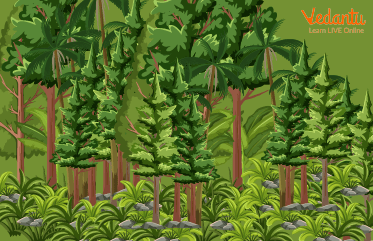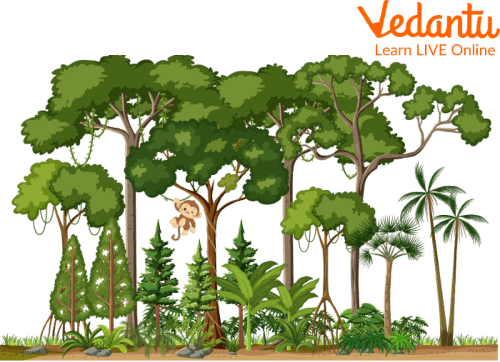




How Do the Four Layers of the Rainforest Help Plants and Animals?
A forest is a section of land where both little and huge trees are present. The temperature and amount of rainfall are used to classify the forests. The term "rainforest" refers to a forest with high annual rainfall and warm winter and summer temperatures. Let's have a look at the main layers of a tropical rainforest.

Rainforest Picture
Every year, the rainforests receive between 250 and 450 centimeters of rain. The typical temperature in these woodlands is above 90 F (32 degrees C). Although they are distinct from one another, jungles and rainforests are occasionally mistaken. Tall trees that cover the top of the forest in a rainforest obscure the majority of the sunlight.
A jungle, on the other hand, is not a constrained area; it may have little trees, taller trees, and open grassy fields. We will also learn about the canopy layer of the rainforest and an emergent layer of the rainforest.
What are the Layers of the Rainforest?
The creatures that inhabit the rainforest have adapted to exist in a certain layer of the forest. The main layers of a tropical rainforest contain a variety of flora and animals.
Emergent Layer of the Rainforest: The longest trees among the layers are in the emergent layer. These trees might grow as tall as 55 meters. The number of trees in this layer is, however, lower than in the canopy layer. The main inhabitants of this layer include bats, eagles, and monkeys.
Canopy Layer of the Rainforest: Except for a few trees in the emergent layer, this layer contains most of the longest trees. The height of the trees in this layer ranges from 35 to 45 meters. Additionally, this layer contains roughly 50% of all plant species.

Layer of Rainforest
Understory Layer of the Rainforest: In a rainforest, the understory layer lies in between the canopy layer and the ground level. In this layer, there are numerous insects and huge leaves on the plants. Jaguars, leopards, lizards, snacks, and many other species can also be found in this tier. The canopy layer receives the majority of the sun's energy. As a result, only around five per cent of sunlight reaches the understory layer.
Forest Floor of the Rainforest: The ground layer of the rainforest is known as the forest floor. Of all the layers, it receives the least sunshine (almost 2%). The majority of the plants that can endure low light are found in this stratum. This layer collects all of the dead plants and their leftovers, which decompose swiftly.
Types of Rainforests
Due to its existence in places with varying temperatures, the rainforest is classified into these two categories. Both tropical and temperate rainforests fall within these two categories.
Tropical Rainforest: Near the equator, in the warm part of the world, are tropical rainforests. The climate in these woodlands is humid. They get more than 170 cm of rain each year, although certain tropical rainforests can get up to 1000 cm. A sizable portion of the world is covered in tropical rainforests. The Philippines, Sri Lanka, South America, Indonesia, Australia, and Malaysia are a few nations with tropical rainforests.
Temperate Rainforests: Temperate rainforests are found where the temperatures are mild throughout the year. They can therefore endure frigid temperatures. These forests are only found in a few places on earth. These forests can be found in North America, Alaska, Scotland, Ireland, and Norway.

Rainforest
Summary
In this article, we discussed what rainforests are. The main emphasis was on the layers of rainforest - emergent, canopy, understory, and forest floor. We also talked about two types of rainforests which are tropical and temperate forests. Forests are vital to life on earth. It is important to us in many ways. If we want to protect ourselves and our planet, then we will have to protect and preserve the forests. We should stop cutting trees unnecessarily.
FAQs on Layers of the Rainforest: Definitions and Facts
1. What are the four main layers of a rainforest?
The four main layers of a rainforest, starting from the top, are:
- The Emergent Layer: The highest layer with the tallest trees.
- The Canopy Layer: A dense layer of treetops that forms a 'roof' over the forest.
- The Understory Layer: A warm, damp, and sheltered area below the canopy.
- The Forest Floor: The darkest layer at the bottom, where decomposition happens.
2. Which layer of the rainforest is called the 'green blanket' and why?
The Canopy Layer is often called the 'green blanket' of the rainforest. This is because the leaves and branches of the tall canopy trees are so tightly packed together that they form a thick, green cover that looks like a blanket when viewed from above. This layer blocks most of the sunlight from reaching the layers below.
3. What is the emergent layer and what makes it unique?
The Emergent Layer is the topmost layer of the rainforest, containing the tallest trees that 'emerge' or poke out above the canopy. This layer is unique because it receives the most direct sunlight and faces strong winds and high temperatures. Animals like eagles, monkeys, and butterflies are often found here.
4. What kind of plants and animals are found in the understory layer?
The Understory Layer is home to plants that have adapted to low light, such as smaller trees, shrubs, and soft-stemmed plants like ferns. Many animals live here because it offers protection from predators and the weather. You can find animals like jaguars, leopards, frogs, and many species of insects in the understory.
5. Why is the forest floor the darkest layer of the rainforest?
The forest floor is the darkest layer because only about 2% of sunlight makes it through the dense Canopy and Understory layers above. The thick leaves of the upper layers block the light, creating a dark, humid environment on the ground where very few plants can grow.
6. How do the different layers of the rainforest depend on each other?
The rainforest layers form an interconnected ecosystem. The Canopy protects the lower layers from sun and rain. When leaves and animals from the upper layers fall to the Forest Floor, they decompose and provide essential nutrients for the soil. These nutrients then help all the plants, including the giant trees of the Emergent Layer, to grow.
7. What are some examples of animals that live in each of the four rainforest layers?
Each rainforest layer has animals adapted to its unique conditions:
- Emergent Layer: Harpy eagles, macaws, and capuchin monkeys.
- Canopy Layer: Toucans, sloths, and orangutans.
- Understory Layer: Jaguars, red-eyed tree frogs, and boa constrictors.
- Forest Floor: Anteaters, tapirs, and many types of insects and worms.
8. What would be the impact on the entire ecosystem if the canopy layer was significantly damaged?
If the Canopy Layer were damaged, it would have a devastating impact. The lower layers would be exposed to harsh sunlight and heavy rain, causing the soil to dry out and erode. Plants in the Understory not adapted to bright light would die, and animals that rely on the canopy for food and shelter, like sloths and toucans, would lose their habitat, disrupting the entire food web.









